La nostra miniguida ti spiega cosa vedere, cosa fare e cosa mangiare per scoprire la città simbolo della pace, che si identifica con uno dei santi più amati e venerati al mondo, San Francesco d’Assisi ed è al contempo una deliziosa cittadina medievale ricca di angoli caratteristici e tipicità culinarie.
Cosa vedere ad Assisi: i luoghi di San Francesco Patrimonio dell’Unesco
Ci sembra d’obbligo cominciare il nostro tour dalla magnifica Basilica di San Francesco, costruita nell’XIII secolo e composta da due parti talmente diverse da essere complementari, la Chiesa Inferiore e la Chiesa Superiore
Varcate le belle porte di quercia scolpite da Niccolò da Gubbio ed entrate nella Chiesa Inferiore; proseguendo in fondo alla navata potrete ammirare la cappella di Santa Caterina, costruita dal famoso cardinale Albornoz, che vi è sepolto. Ammirate le meravigliose cappelle laterali dipinte da artisti del calibro di Giovanni da Cosma e Taddeo Gaddi, così come la volta della navata che è una vera e propria opera d’arte con affreschi ad opera di diversi artisti tra cui Simone Martini, Giotto e la sua scuola.
In fondo alla navata ecco l’altare maggiore, eretto in corrispondenza della tomba di San Francesco, sopra il quale troneggiano quattro grandi affreschi in cui Giotto ha glorificato le tre virtù fondamentali della Regola francescana: Povertà, Obbedienza e Castità
Dalla Chiesa Inferiore si può scendere alla cripta nella quale riposa la salma del Santo.
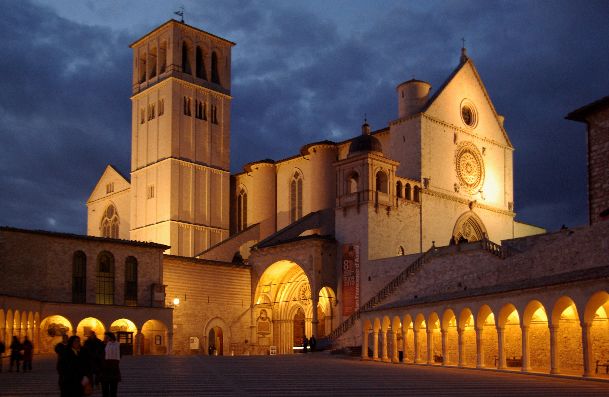
Non tutti sanno che …
Questo sotterraneo è stato ricavato interamente lasciando intatto il masso calcareo che conteneva il sarcofago del Santo!
Fermatevi ora a guardare la Chiesa Superiore, con la sua famosa facciata gotica lineare e raffinata al cui centro troneggia un bellissimo rosone. Una volta entrati verrete stregati dalla luce che filtra attraverso le artistiche vetrate, in contrasto con la Chiesa Inferiore nella quale la luce è notevolmente minore.
La parte superiore è ricoperta di affreschi che narrano del Vecchio e Nuovo testamento, la cui attribuzione è ancora incerta dopo la tesi che voleva affidare la paternità a Giotto e a Cimabue. Le pareti inferiori sono invece opera di Giotto e della sua scuola. Questo è il ciclo pittorico più importante ed interessante dell’iconografia francescana
Non tutti sanno che …
Fra i 28 meravigliosi affreschi di Giotto che narrano la vita di San Francesco nella Basilica di Assisi, ce n`è uno in cui si vede il Santo che appare ai suoi compagni su un carro di fuoco, una visione che i frati ebbero un giorno nella Chiesa di San Rufino, mentre San Francesco era intento a pregare.
Cosa vedere a Assisi dopo questa meraviglia? Proseguendo per Via San Francesco raggiungerete la medievale Piazza del Comune attorno a cui spicca il Tempio di Minerva, risalente al I secolo a.C., un vero gioiello d’arte antica.
Per percorrere le orme del Santo, uscite dalla piazza e scendete subito a destra vi trovate davanti alla Chiesa Nuova, realizzata nel ‘600 sulla casa natale di S. Francesco. Costeggiando la chiesa si arriva all’Oratorio di S. Francesco Piccolino, nel quale secondo la leggenda nacque il Santo.
Percorso Corso Mazzini vi trovate in Piazza S. Chiara, dominata dall’omonima Basilica. All’interno della Basilica di S. Chiara, potete ammirare i resti della Santa e il bellissimo crocifisso ligneo che, sempre secondo la leggenda, parlò a S. Francesco.
Non tutti sanno che …
I trovatori provenzali si diffusero in tutta Europa e scesero anche ad Assisi. Da essi Francesco imparò l`arte del poetare, facilitato dal fatto di conoscere la lingua francese da sua madre, avendo egli stesso origini provenzali
Cosa fare ad Assisi
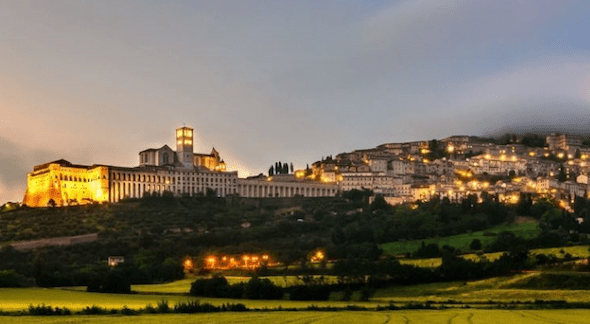
Cosa fare a Assisi? Non dimenticate di fare tappa alla Cattedrale di S. Rufino, vescovo, martire e patrono di Assisi. L’interno della chiesa, cinquecentesco, custodisce una cisterna romana, la fonte battesimale al quale furono battezzati Francesco e Chiara, e la meravigliosa cripta della Basilica Ugoniana che risale al XII secolo.
Un’idea originale su cosa fare a Assisi è il giro delle mura medievali ed il varco delle relative porte che sono ben 7, senza dimenticare di scattare una foto da cartolina dalla Rocca Maggiore.
PER FOTO MOZZAFIATO… Per godere del migliore panorama di Assisi raggiungete la Rocca Maggiore da cui avrete una vista stupenda sulla città intera e su parte della vallata!
Inoltre, andate alla scoperta dei luoghi più umili legati a San Francesco:
- la Porziuncola di Santa Maria Degli Angeli;
- l’Eremo delle Carceri, un luogo immerso nella natura a soli 4 chilometri dal centro storico di Assisi dedito alla ricerca spirituale, dove San Francesco e i suoi seguaci si ritrovavano proprio per pregare e meditare, circondati dal silenzio e dalla spiritualità della natura;
- il Bosco di San Francesco, un’area incontaminata di 64 ettari situata ai piedi della Basilica di San Francesco, splendido esempio di paesaggio rurale italiano dove immergersi nella pace e nell’armonia, passeggiando tra terreni boschivi e radure, campi coltivati e oliveti.
Cosa mangiare a Assisi
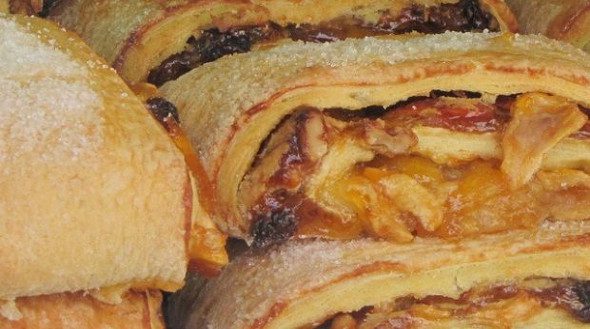
Assisi non si limiterà a colmare la vostra fame… di spiritualità, per questo la nostra miniguida è pronta a suggerirvi cosa mangiare a Assisi.
Non ripartite senza aver gustato almeno 4 specialità Assisane:
- Pecorino
- Ciauscolo, salame spalmabile costituito da un impasto di carne di maiale
- Umbricelli, (chiamati dialettalmente umbrichi, umbrichelli o umbrichelle), grossi spaghetti fatti a mano, al tartufo o alla norcina
- Rocciata, dolce di origine medievale tipico di Assisi, ripieno di mele, nocciole, noci e uvetta
Here is a mini guide to discover the best things to do in Assisi. The city symbol of peace which identifies itself with one of the most beloved and revered saints in the world, St. Francis of Assisi, it is at the same time a delightful medieval town with lots of hidden corners and typical foods.
>> Do you want to visit Assisi? Check it out now of the best hotels in Assisi Italy
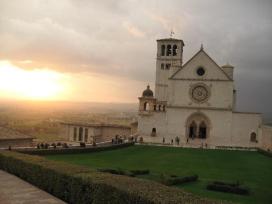 You must begin your Assisi tour with the beautiful Basilica of St. Francis, built in the XIII century established by two parts so different as complementary, the Lower Church and the Upper Church. Enter through the big oak doors carved by Niccolò da Gubbio and enter the Lower Church, going down the nave you will admire the St. Catherine’s Chapel, built by the famous Cardinal Albornoz, who is buried there. Go into the main nave and admire the wonderful side chapels painted by Giovanni da Cosma and Taddeo Gaddi, as well as the vault of the nave with wonderful frescoes by various artists including Simone Martini, Giotto and his school.
You must begin your Assisi tour with the beautiful Basilica of St. Francis, built in the XIII century established by two parts so different as complementary, the Lower Church and the Upper Church. Enter through the big oak doors carved by Niccolò da Gubbio and enter the Lower Church, going down the nave you will admire the St. Catherine’s Chapel, built by the famous Cardinal Albornoz, who is buried there. Go into the main nave and admire the wonderful side chapels painted by Giovanni da Cosma and Taddeo Gaddi, as well as the vault of the nave with wonderful frescoes by various artists including Simone Martini, Giotto and his school.
Down the nave you will find the high altar, erected at the tomb of St. Francis, which dominate over the four great Giotto frescoes in which he glorified the three fundamental virtues of the Franciscan Rule: Poverty, Chastity and Obedience. From the Lower Church you can go down to the crypt in which rests the body of the Saint.
Perhaps you did not know that… >> This basement has been converted entirely leaving intact the limestone rock which contained the sarcophagus of the saint!
Now look at the Upper Church, with its famous Gothic facade which has in its center a beautiful rose window. Once entered you will be enchanted by the light filtering through the stained-glass windows, in contrast to the lower church in which the light is significantly lower. The top is covered with frescoes narrating the Old and New Testament, whose attribution is still uncertain after the thesis that wanted to entrust the authorship of Giotto and Cimabue. The lower walls are works by Giotto and his school. This is the most important and interesting series of Franciscan paintings.
Perhaps you did not know that… >> In the Assisi Church among the 28 beautiful frescoes by Giotto that narrate the life of St. Francis, there is one representing the Saint who appears to his companions in a chariot of fire. This is a vision that friars had in the Church of San Rufino, while St. Francis was praying.
>> Do you want to discover Assisi’s treasures? Check it out now of the best farmhouses in Assisi.
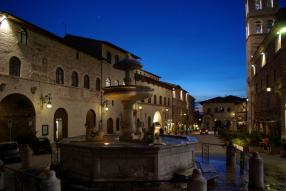 Outputs from the Upper Church, you will walk along Via San Francesco to reach the medieval Piazza del Comune around which stands the Temple of Minerva, dating from the first century B.C., a true jewel of ancient art. Returning in the footsteps of the Saint, leave the square and go down. At your right you will see the New Church, built in 600 on the birthplace of S. Francis. Around the church you come to the Oratory of St. Francis Piccolino, in which according to legend was born the Saint. Walking along Corso Mazzini you will arrive in Piazza S. Chiara, overlooked by the Basilica of St. Clare. Inside it, you will admire the remains of the Saint and the beautiful wooden crucifix which, according to legend, spoke to S. Francis.
Outputs from the Upper Church, you will walk along Via San Francesco to reach the medieval Piazza del Comune around which stands the Temple of Minerva, dating from the first century B.C., a true jewel of ancient art. Returning in the footsteps of the Saint, leave the square and go down. At your right you will see the New Church, built in 600 on the birthplace of S. Francis. Around the church you come to the Oratory of St. Francis Piccolino, in which according to legend was born the Saint. Walking along Corso Mazzini you will arrive in Piazza S. Chiara, overlooked by the Basilica of St. Clare. Inside it, you will admire the remains of the Saint and the beautiful wooden crucifix which, according to legend, spoke to S. Francis.
Perhaps you did not know that… >> Provençal troubadours spread all over Europe and even went down to Assisi. From them Francesco learned the art of poetry, facilitated by the knowledge of the French language from his mother, having he himself origins in Provence.
Things to do in Assisi
One of the best things to do in Assisi is surely a visit at St Rufino Cathedral, the church dedicated to Assisi’s Patron St. Rufino. In the interior of the church you will find a Roman cistern, the baptismal font in which Francis and Clare were baptized, and the beautiful crypt of Basilica Ugoniana which dates back to the twelfth century.
Take a look at Francis’ poor places: the Hermitage and Basilica of Saint Mary of the Angels with its Porziuncola Chapel.
One of the most original things to do in Assisi is a tour of the medieval walls and don’t forget Rocca Maggiore to make amazing photos!
Assisi’s food, Umbrian cuisine, Italian food
Assisi has not only food for the soul and our mini-guide wants to suggest you what to eat in Assisi.
See the best restaurants in the area of Assisi! >> Click here and book.

It is forbidden to leave Assisi without have tasted at least 4 culinary delights:
- Pecorino
- Ciauscolo, spreadable salami made from a mixture of pork
- Umbricelli, thick handmade spaghetti with truffles or norcina style
- Rocciata, typical cake with medieval origin stuffed with apples, hazelnuts, walnuts and raisins
FOR BREATHTAKING PHOTOS >> To enjoy the best view of Assisi and see the entire city and part of the valley reach Rocca Maggiore
If you’ve decided to visit Assisi and taste the delicious Umbrian cuisine you should contact now farmhouses near Assisi >> click this link.
Here is a mini guide to discover the best things to do in Assisi. The city symbol of peace which identifies itself with one of the most beloved and revered saints in the world, St. Francis of Assisi, it is at the same time a delightful medieval town with lots of hidden corners and typical foods.
>> Do you want to visit Assisi? Check it out now of the best hotels in Assisi Italy
 You must begin your Assisi tour with the beautiful Basilica of St. Francis, built in the XIII century established by two parts so different as complementary, the Lower Church and the Upper Church. Enter through the big oak doors carved by Niccolò da Gubbio and enter the Lower Church, going down the nave you will admire the St. Catherine’s Chapel, built by the famous Cardinal Albornoz, who is buried there. Go into the main nave and admire the wonderful side chapels painted by Giovanni da Cosma and Taddeo Gaddi, as well as the vault of the nave with wonderful frescoes by various artists including Simone Martini, Giotto and his school.
You must begin your Assisi tour with the beautiful Basilica of St. Francis, built in the XIII century established by two parts so different as complementary, the Lower Church and the Upper Church. Enter through the big oak doors carved by Niccolò da Gubbio and enter the Lower Church, going down the nave you will admire the St. Catherine’s Chapel, built by the famous Cardinal Albornoz, who is buried there. Go into the main nave and admire the wonderful side chapels painted by Giovanni da Cosma and Taddeo Gaddi, as well as the vault of the nave with wonderful frescoes by various artists including Simone Martini, Giotto and his school.
Down the nave you will find the high altar, erected at the tomb of St. Francis, which dominate over the four great Giotto frescoes in which he glorified the three fundamental virtues of the Franciscan Rule: Poverty, Chastity and Obedience. From the Lower Church you can go down to the crypt in which rests the body of the Saint.
Perhaps you did not know that… >> This basement has been converted entirely leaving intact the limestone rock which contained the sarcophagus of the saint!
Now look at the Upper Church, with its famous Gothic facade which has in its center a beautiful rose window. Once entered you will be enchanted by the light filtering through the stained-glass windows, in contrast to the lower church in which the light is significantly lower. The top is covered with frescoes narrating the Old and New Testament, whose attribution is still uncertain after the thesis that wanted to entrust the authorship of Giotto and Cimabue. The lower walls are works by Giotto and his school. This is the most important and interesting series of Franciscan paintings.
Perhaps you did not know that… >> In the Assisi Church among the 28 beautiful frescoes by Giotto that narrate the life of St. Francis, there is one representing the Saint who appears to his companions in a chariot of fire. This is a vision that friars had in the Church of San Rufino, while St. Francis was praying.
>> Do you want to discover Assisi’s treasures? Check it out now of the best farmhouse in Assisi.
 Outputs from the Upper Church, you will walk along Via San Francesco to reach the medieval Piazza del Comune around which stands the Temple of Minerva, dating from the first century B.C., a true jewel of ancient art. Returning in the footsteps of the Saint, leave the square and go down. At your right you will see the New Church, built in 600 on the birthplace of S. Francis. Around the church you come to the Oratory of St. Francis Piccolino, in which according to legend was born the Saint. Walking along Corso Mazzini you will arrive in Piazza S. Chiara, overlooked by the Basilica of St. Clare. Inside it, you will admire the remains of the Saint and the beautiful wooden crucifix which, according to legend, spoke to S. Francis.
Outputs from the Upper Church, you will walk along Via San Francesco to reach the medieval Piazza del Comune around which stands the Temple of Minerva, dating from the first century B.C., a true jewel of ancient art. Returning in the footsteps of the Saint, leave the square and go down. At your right you will see the New Church, built in 600 on the birthplace of S. Francis. Around the church you come to the Oratory of St. Francis Piccolino, in which according to legend was born the Saint. Walking along Corso Mazzini you will arrive in Piazza S. Chiara, overlooked by the Basilica of St. Clare. Inside it, you will admire the remains of the Saint and the beautiful wooden crucifix which, according to legend, spoke to S. Francis.
Perhaps you did not know that… >> Provençal troubadours spread all over Europe and even went down to Assisi. From them Francesco learned the art of poetry, facilitated by the knowledge of the French language from his mother, having he himself origins in Provence.
Things to do in Assisi
One of the best things to do in Assisi is surely a visit at St Rufino Cathedral, the church dedicated to Assisi’s Patron St. Rufino. In the interior of the church you will find a Roman cistern, the baptismal font in which Francis and Clare were baptized, and the beautiful crypt of Basilica Ugoniana which dates back to the twelfth century.
Take a look at Francis’ poor places: the Hermitage and Basilica of Saint Mary of the Angels with its Porziuncola Chapel.
One of the most original things to do in Assisi is a tour of the medieval walls and don’t forget Rocca Maggiore to make amazing photos!
Assisi’s food, Umbrian cuisine, Italian food
Assisi has not only food for the soul and our mini-guide wants to suggest you what to eat in Assisi.
See the best restaurants in the area of Assisi! >> Click here and book.

It is forbidden to leave Assisi without have tasted at least 4 culinary delights:
- Pecorino
- Ciauscolo, spreadable salami made from a mixture of pork
- Umbricelli, thick handmade spaghetti with truffles or norcina style
- Rocciata, typical cake with medieval origin stuffed with apples, hazelnuts, walnuts and raisins
FOR BREATHTAKING PHOTOS >> To enjoy the best view of Assisi and see the entire city and part of the valley reach Rocca Maggiore
If you’ve decided to visit Assisi and taste the delicious Umbrian cuisine you should contact now farmhouses near Assisi >> click this link.
Here is a mini guide to discover the best things to do in Assisi. The city symbol of peace which identifies itself with one of the most beloved and revered saints in the world, St. Francis of Assisi, it is at the same time a delightful medieval town with lots of hidden corners and typical foods.
>> Do you want to visit Assisi? Check it out now of the best hotels in Assisi Italy
 You must begin your Assisi tour with the beautiful Basilica of St. Francis, built in the XIII century established by two parts so different as complementary, the Lower Church and the Upper Church. Enter through the big oak doors carved by Niccolò da Gubbio and enter the Lower Church, going down the nave you will admire the St. Catherine’s Chapel, built by the famous Cardinal Albornoz, who is buried there. Go into the main nave and admire the wonderful side chapels painted by Giovanni da Cosma and Taddeo Gaddi, as well as the vault of the nave with wonderful frescoes by various artists including Simone Martini, Giotto and his school.
You must begin your Assisi tour with the beautiful Basilica of St. Francis, built in the XIII century established by two parts so different as complementary, the Lower Church and the Upper Church. Enter through the big oak doors carved by Niccolò da Gubbio and enter the Lower Church, going down the nave you will admire the St. Catherine’s Chapel, built by the famous Cardinal Albornoz, who is buried there. Go into the main nave and admire the wonderful side chapels painted by Giovanni da Cosma and Taddeo Gaddi, as well as the vault of the nave with wonderful frescoes by various artists including Simone Martini, Giotto and his school.
Down the nave you will find the high altar, erected at the tomb of St. Francis, which dominate over the four great Giotto frescoes in which he glorified the three fundamental virtues of the Franciscan Rule: Poverty, Chastity and Obedience. From the Lower Church you can go down to the crypt in which rests the body of the Saint.
Perhaps you did not know that… >> This basement has been converted entirely leaving intact the limestone rock which contained the sarcophagus of the saint!
Now look at the Upper Church, with its famous Gothic facade which has in its center a beautiful rose window. Once entered you will be enchanted by the light filtering through the stained-glass windows, in contrast to the lower church in which the light is significantly lower. The top is covered with frescoes narrating the Old and New Testament, whose attribution is still uncertain after the thesis that wanted to entrust the authorship of Giotto and Cimabue. The lower walls are works by Giotto and his school. This is the most important and interesting series of Franciscan paintings.
Perhaps you did not know that… >> In the Assisi Church among the 28 beautiful frescoes by Giotto that narrate the life of St. Francis, there is one representing the Saint who appears to his companions in a chariot of fire. This is a vision that friars had in the Church of San Rufino, while St. Francis was praying.
>> Do you want to discover Assisi’s treasures? Check it out now of the best farmhouse in Assisi.
 Outputs from the Upper Church, you will walk along Via San Francesco to reach the medieval Piazza del Comune around which stands the Temple of Minerva, dating from the first century B.C., a true jewel of ancient art. Returning in the footsteps of the Saint, leave the square and go down. At your right you will see the New Church, built in 600 on the birthplace of S. Francis. Around the church you come to the Oratory of St. Francis Piccolino, in which according to legend was born the Saint. Walking along Corso Mazzini you will arrive in Piazza S. Chiara, overlooked by the Basilica of St. Clare. Inside it, you will admire the remains of the Saint and the beautiful wooden crucifix which, according to legend, spoke to S. Francis.
Outputs from the Upper Church, you will walk along Via San Francesco to reach the medieval Piazza del Comune around which stands the Temple of Minerva, dating from the first century B.C., a true jewel of ancient art. Returning in the footsteps of the Saint, leave the square and go down. At your right you will see the New Church, built in 600 on the birthplace of S. Francis. Around the church you come to the Oratory of St. Francis Piccolino, in which according to legend was born the Saint. Walking along Corso Mazzini you will arrive in Piazza S. Chiara, overlooked by the Basilica of St. Clare. Inside it, you will admire the remains of the Saint and the beautiful wooden crucifix which, according to legend, spoke to S. Francis.
Perhaps you did not know that… >> Provençal troubadours spread all over Europe and even went down to Assisi. From them Francesco learned the art of poetry, facilitated by the knowledge of the French language from his mother, having he himself origins in Provence.
Things to do in Assisi
One of the best things to do in Assisi is surely a visit at St Rufino Cathedral, the church dedicated to Assisi’s Patron St. Rufino. In the interior of the church you will find a Roman cistern, the baptismal font in which Francis and Clare were baptized, and the beautiful crypt of Basilica Ugoniana which dates back to the twelfth century.
Take a look at Francis’ poor places: the Hermitage and Basilica of Saint Mary of the Angels with its Porziuncola Chapel.
One of the most original things to do in Assisi is a tour of the medieval walls and don’t forget Rocca Maggiore to make amazing photos!
Assisi’s food, Umbrian cuisine, Italian food
Assisi has not only food for the soul and our mini-guide wants to suggest you what to eat in Assisi.
See the best restaurants in the area of Assisi! >> Click here and book.

It is forbidden to leave Assisi without have tasted at least 4 culinary delights:
- Pecorino
- Ciauscolo, spreadable salami made from a mixture of pork
- Umbricelli, thick handmade spaghetti with truffles or norcina style
- Rocciata, typical cake with medieval origin stuffed with apples, hazelnuts, walnuts and raisins
FOR BREATHTAKING PHOTOS >> To enjoy the best view of Assisi and see the entire city and part of the valley reach Rocca Maggiore
If you’ve decided to visit Assisi and taste Umbrian cuisine you should contact now farmhouses near Assisi>> click this link.
Here is a mini guide to discover the best things to do in Assisi. The city symbol of peace which identifies itself with one of the most beloved and revered saints in the world, St. Francis of Assisi, it is at the same time a delightful medieval town with lots of hidden corners and typical foods.
>> Do you want to visit Assisi? Check it out now of the best hotels in Assisi Italy
You must begin your Assisi tour with the beautiful Basilica of St. Francis, built in the XIII century established by two parts so different as complementary, the Lower Church and the Upper Church. Enter through the big oak doors carved by Niccolò da Gubbio and enter the Lower Church, going down the nave you will admire the St. Catherine’s Chapel, built by the famous Cardinal Albornoz, who is buried there. Go into the main nave and admire the wonderful side chapels painted by Giovanni da Cosma and Taddeo Gaddi, as well as the vault of the nave with wonderful frescoes by various artists including Simone Martini, Giotto and his school.
Down the nave you will find the high altar, erected at the tomb of St. Francis, which dominate over the four great Giotto frescoes in which he glorified the three fundamental virtues of the Franciscan Rule: Poverty, Chastity and Obedience. From the Lower Church you can go down to the crypt in which rests the body of the Saint.
Perhaps you did not know that… >> This basement has been converted entirely leaving intact the limestone rock which contained the sarcophagus of the saint!
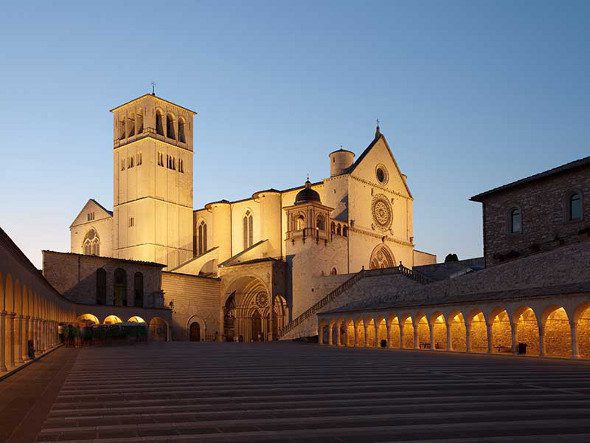
Now look at the Upper Church, with its famous Gothic facade which has in its center a beautiful rose window. Once entered you will be enchanted by the light filtering through the stained-glass windows, in contrast to the lower church in which the light is significantly lower. The top is covered with frescoes narrating the Old and New Testament, whose attribution is still uncertain after the thesis that wanted to entrust the authorship of Giotto and Cimabue. The lower walls are works by Giotto and his school. This is the most important and interesting series of Franciscan paintings.
Perhaps you did not know that… >> In the Assisi Church among the 28 beautiful frescoes by Giotto that narrate the life of St. Francis, there is one representing the Saint who appears to his companions in a chariot of fire. This is a vision that friars had in the Church of San Rufino, while St. Francis was praying.
>> Do you want to discover Assisi’s treasures? Check it out now of the best farmhouse in Assisi.
Outputs from the Upper Church, you will walk along Via San Francesco to reach the medieval Piazza del Comune around which stands the Temple of Minerva, dating from the first century B.C., a true jewel of ancient art. Returning in the footsteps of the Saint, leave the square and go down. At your right you will see the New Church, built in 600 on the birthplace of S. Francis. Around the church you come to the Oratory of St. Francis Piccolino, in which according to legend was born the Saint. Walking along Corso Mazzini you will arrive in Piazza S. Chiara, overlooked by the Basilica of St. Clare. Inside it, you will admire the remains of the Saint and the beautiful wooden crucifix which, according to legend, spoke to S. Francis.
Perhaps you did not know that… >> Provençal troubadours spread all over Europe and even went down to Assisi. From them Francesco learned the art of poetry, facilitated by the knowledge of the French language from his mother, having he himself origins in Provence.
Things to do in Assisi
One of the best things to do in Assisi is surely a visit at St Rufino Cathedral, the church dedicated to Assisi’s Patron St. Rufino. In the interior of the church you will find a Roman cistern, the baptismal font in which Francis and Clare were baptized, and the beautiful crypt of Basilica Ugoniana which dates back to the twelfth century.
Take a look at Francis’ poor places: the Hermitage and Basilica of Saint Mary of the Angels with its Porziuncola Chapel. One of the most original things to do in Assisi is a tour of the medieval walls and don’t forget Rocca Maggiore to make amazing photos!
Assisi’s food, Umbrian cuisine, Italian food
Assisi has not only food for the soul and our mini-guide wants to suggest you what to eat in Assisi.
See the best restaurants in the area of Assisi! >> Click here and book.

It is forbidden to leave Assisi without have tasted at least 4 culinary delights:
- Pecorino
- Ciauscolo, spreadable salami made from a mixture of pork
- Umbricelli, thick handmade spaghetti with truffles or norcina style
- Rocciata, typical cake with medieval origin stuffed with apples, hazelnuts, walnuts and raisins
FOR BREATHTAKING PHOTOS >> To enjoy the best view of Assisi and see the entire city and part of the valley reach Rocca Maggiore
If you’ve decided to visit Assisi and taste Umbrian cuisine you should contact now farmhouses near Assisi>> click this link.









Comment (0)